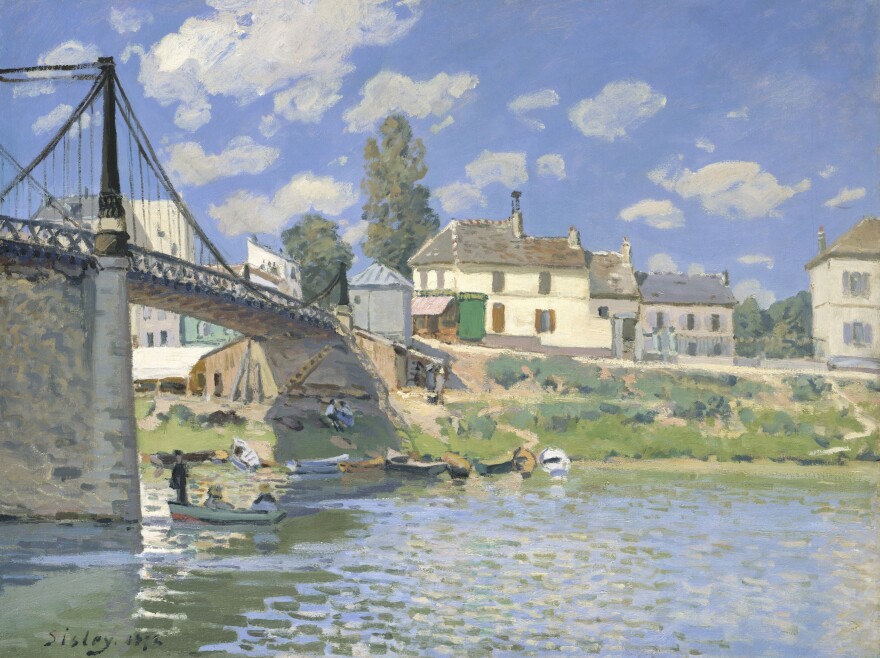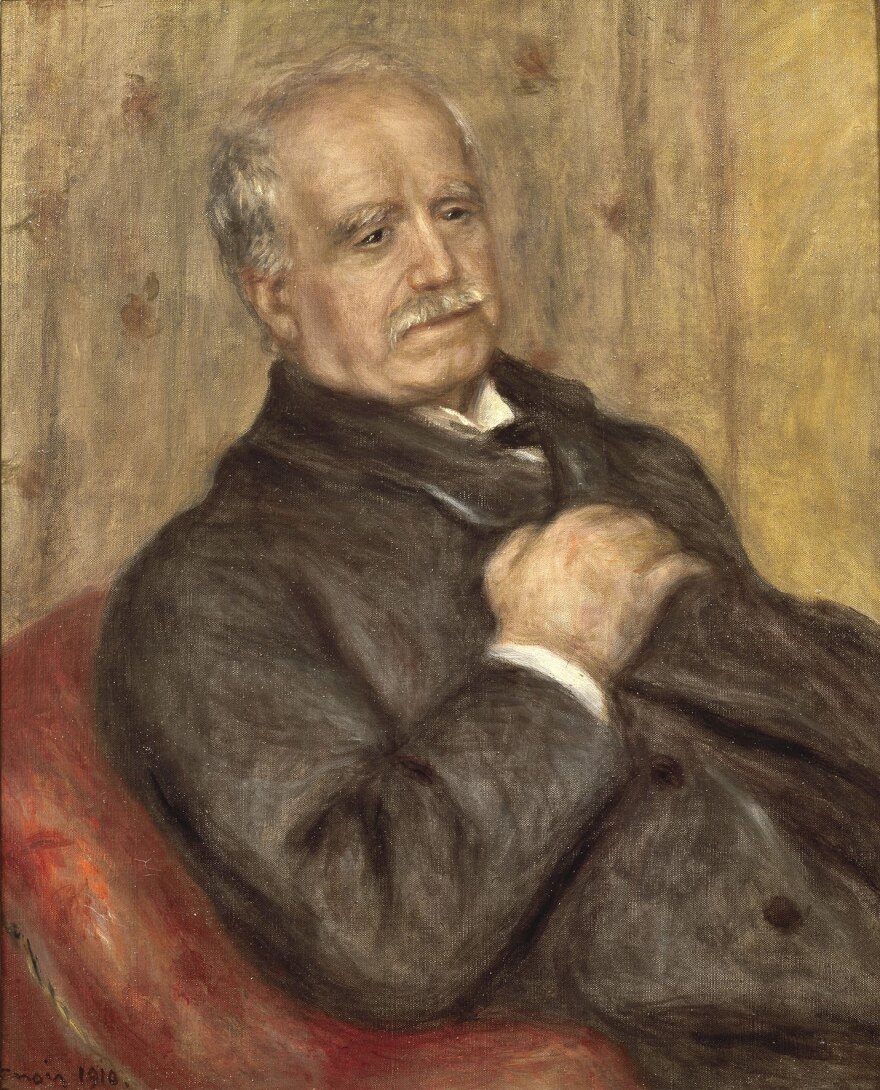It might seem unusual for an exhibit to focus on a man who sold paintings rather than the artists who painted them. But there was one particular 19th century Paris art dealer who shaped the art market of his day — and ours — by discovering artists who became world-wide favorites. He's now the subject of a major exhibition in Philadelphia.
Paul Durand-Ruel was quite the shopper. He was the first buyer of Renoir's Luncheon of the Boating Party, Monet's Stacks of Wheat (End of Day Autumn), some 100 works in the Musée d'Orsay's impressionist collection in Paris, and more than than 100 paintings in Dr. Albert Barnes' Foundation in Philadelphia — all purchased from Durand-Ruel.

"He bought over 1,000 Monets, 1,500 Renoirs, 800 Pissarros, 400 Sisleys, 400 Cassatts, and about 200 Manets," says Philadelphia Museum of Art curator Jennifer Thompson. "So over 5,000 impressionist pictures all told."
It was Durand-Ruel who spotted their talent before anyone else. In 1870, during the Franco-Prussian War, Durand-Ruel packed up all his stock, left Paris and went to London. There, an artist friend — also an émigré — gave him some advice: He should go check out the work of two guys named Monet and Pissarro.
Or, at least that's how Thompson's co-curator Joe Rishel tells it. Thompson has a slightly different version. Here's how she says it happened: "One of his artists came in one day with a young French painter, introducing him and saying, 'This artist will surpass us all' — and that artist was Claude Monet."
Pissarro heard about all the Monets Durand-Ruel had bought, and — not wanting to miss out — brought his work over. The dealer was not in, but Pissaro left his paintings at the gallery.
"Durand-Ruel immediately writes him a letter saying: 'I'm so sorry I missed you. I'm delighted with the paintings you left. Could you name a price and bring me others?' " says Thompson. "So that of course was the start of what would be the pivotal movement of Durand-Ruel's career, which was the meeting of the impressionists."

Eventually the dealer went back to Paris. He met Degas, Sisley, Renoir and others, and — in a move that was quite unusual — started buying out their studios.
"He buys 29 Pissarros, 29 Sisleys, 10 Degases, two Renoirs — all within the first year of meeting these artists," Thompson says.

Buying so much so early was an innovation, Thompson explains. "Other dealers would buy 10 works, wait for them to sell and then come back and buy more. But he was very innovative in buying large amounts of work. ... It enabled him to corner the market, and it also was a tremendous show of support for the artist."
But it was also risky business.
"It was quite a big gamble to invest so much money and much of his potential resources into artists," says Thompson. "And in the case of the impressionists, he was investing in artists who were not widely recognized ... or liked. [It was] the rare collector in 1870s who would buy an impressionist painting."
It often took 10 to 20 years for Durand-Ruel to sell some of the paintings. Monet's brushy picture of a misty morning in London's Green Park, Manet's image of a battle between two ships carrying supplies in the American Civil War, Degas' pale ballerinas — there was no ready audience for those works.
In 1876, when he filled three rooms of his gallery at 11 rue Le Peletier with art for the second impressionist show, French critics were vicious. In response to a Renoir nude depicted in a sun-dappled setting, critics commented: "Go ahead and try to explain to Renoir a woman's flesh doesn't look like decomposing flesh — it's not composed of purple and green splotches."

But Durand-Ruel remained loyal to his artists. He gave them one-man shows — another innovation — and supported them in all sorts of ways.
"He became a very good friend of the impressionists and would offer them stipends," Thompson says. "When they needed to pay rent or had bills, he would offer them loans. Even later into the 1890s he was making advances allowing them to buy some great properties. So when Monet goes to buy his property at Giverny, he does so with an advance against pictures that he's going to be presenting at Durand-Ruel's gallery."
There were dark days when Durand-Ruel went broke. And days when his artists lost faith in their own work. Thompson says in one series of letters to the dealer, Monet expresses the frustration he is having while painting on the Norman coast. He threatens to destroy his canvases. "And Durand-Ruel says: 'Please don't do that. I'll send you money. Just send me the canvases in return.' So he's also offering guidance and saying: 'Don't despair if you're feeling like you're in a rut artistically. I believe in you. Continue to paint and we'll find a market.' "

In addition to friendship, and financial and moral support, the dealer gave the painters his trust. "Durand-Ruel never had contracts with his artists that established a kind of exclusive relationship," says Thompson, "but he did pride himself and really prized his relationship with artists and got very nervous when they started talking to other dealers. He wanted to be the exclusive dealer for impressionists, and that made sense because he had the largest stock of anyone."

So was he a visionary, an art lover, or a canny businessman? Thompson says it was all of the above.
"He talks constantly in his memoirs about his love of art and his support of artists," she says, "but he is an extraordinary businessman and an entrepreneur. When you look at his business practices, he was extraordinarily clever."
Case in point: It was obvious that Europe didn't like the impressionists very much. So in 1886 the dealer packed up 300 works in 43 crates and took them by boat to America. He spent three months in the U.S., putting on an exhibition — traveling to Washington, Cincinnati, Philadelphia, visiting collectors. He sold 49 pictures for about $40,000 — nice money for art in those days. A year later he opened a gallery in New York. (It operated until 1950!) Many of the works he sold became the centerpieces of impressionist collections in major American museums.
To think that, had I passed away at 60, I would have died debt-ridden and bankrupt, surrounded by a wealth of underrated treasures.
So America saved Durand-Ruel and his painters. And his painters were saved by Durand-Ruel. Just before the end of his life, Monet said: "We would have died of hunger without Durand-Ruel, all we impressionists."
Durand-Ruel himself died in 1922 at the age of 89. "At last the impressionist masters triumphed," he said. "My madness had been wisdom. To think that, had I passed away at 60, I would have died debt-ridden and bankrupt, surrounded by a wealth of underrated treasures."
"Discovering the Impressionists: Paul Durand-Ruel and the New Painting" is at the Philadelphia Museum of Art — its only U.S. venue — through Sept. 13. It's a show about a principled, devoted dealer and the artists he supported in so many unprecedented ways.
Copyright 2021 NPR. To see more, visit https://www.npr.org.



